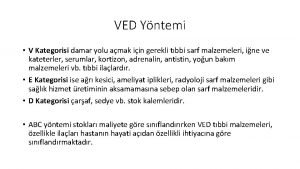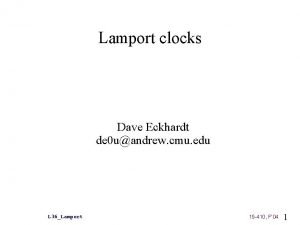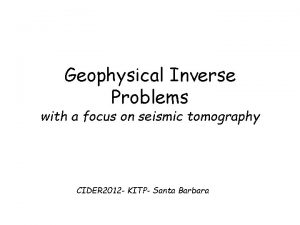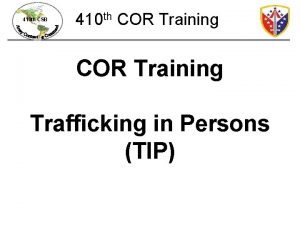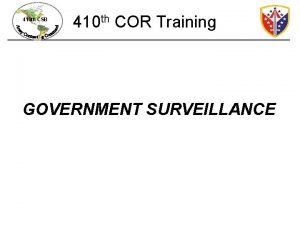Data Structures and Analysis COMP 410 David Stotts


























- Slides: 26

Data Structures and Analysis (COMP 410) David Stotts Computer Science Department UNC Chapel Hill

Sorting

Sorting Fundamental Problem in many applications Ebay: ◦ I got 300, 000 hits on my search for “widgets” please put them into “ending soonest” order ◦ Put them into “lowest price first” order ◦ This happens in ½ second or so Efficiency is critical for large data sets

Bubble Sort has been our gold standard for badness • O(N^2) worst case time complexity for lists of N items It works “in-place” • means if we have the items in an array, the sort happens without needing another array of size N as “temp” space It is “stable” • means it preserves original order for items with the same value

Stability Original unsorted list: ◦ 3, 5, 1, 8, 2, 7, 9, 2, 4 Stable sort gives this: ◦ 1, 2, 2, 3, 4, 5, 7, 8, 9 Unstable sort might give this: ◦ 1, 2, 2, 3, 4, 5, 7, 8, 9 This matters if you have secondary keys to sort on as well as primary key

Insertion Sort is a comparison and “swap” sort � O(N^2) worst case time complexity for lists of N items in-place , stable • • Pass through main array once Compare current item to its up neighbor If out of order, pull out up neighbor and shift elements up until you find a slot the item belongs between “insert” due to shifting Stable ? YES

Selection Sort is a comparison and “swap” sort � O(N^2) worst case time complexity for lists of N items in-place not inherently stable (due to long range swaps) Pass through main array N times Each pass i, find smallest item in array and swap it with slot i Stable ? NO

Heap Sort we studied with heaps � O(N log N) worst case time complexity for list of N items not in-place (the way we discussed in class is not) not stable (due to heap) Do Build. Heap with array of items ( O(N) ) Do del. Min N times back into array ( O(N log N) ) Stable ? NO

In-Place Heap Sort can be done in-place (still not stable) • Build. Heap loads all elements into an array • del. Min removes an element from heap array • This makes one array slot open (at the end) • Put removed element at array end (heap last+1) • Keep doing this… when heap is empty array will contain all the elements in reverse order

In-Place Heap Sort Elements: 7, 2, 19, 8, 11, 4, 16 Load heap array: x 0 7 1 2 19 2 3 8 11 4 5 Complete Build: x 0 2 1 7 2 8 11 19 16 4 5 6 7 First del. Min: x 0 4 1 7 16 2 3 Next del. Min: x 0 7 1 8 16 19 11 2 3 4 5 Final array: x 19 16 11 0 1 2 3 4 16 6 7 8 11 19 4 5 6 8 4 7 5 2 7 4 6 2 7

Recall: Big O is an Upper Bound � 5 N^2, N^3, N^5, 15*(2^N), N!, etc.

Big O Visual Illustration N ( adapted from Kahn Academy )

Big W is Lower Bound � N, sqrt(N), log N, N log N, 1, etc.

Big W Visual Illustration N ( adapted from Kahn Academy )

Big Q is Both Bounds �

Big Q Visual Illustration N ( adapted from Kahn Academy )

Complexity of Sorting by swapping two elements • We know it is O( N log N ) from other discussions • We can prove it is W( N log N ) … see text, using • So this means it is also Q( N log N ) decision tree

Merge Sort we discussed when I had to sort your midterms � O(N log N) worst case time complexity for list of N items can be in-place, usually done with extra arrays can easily be made stable � Halve list repeatedly until single elements ( O(log N) ) � Merge neighbor 1 -lists into 2 -lists � Repeat (2 -lists, into 4 -lists, etc. ) Stable ? YES

Analysis of Merge Sort Solve a recurrence relation time to MS list of size 1 T(1) = 1 time to MS list of size N T(N) = 2 * T(N/2) + N time to merge 2 halves time to MS sort half the list T(N) = 2 * T(N/2) + N --------N N divide both sides by N T(N) T(N/2) ---- = ------ + 1 N N/2

Analysis of Merge Sort Solve a recurrence relation T(N/2) T(N/4) ------ = ------ + 1 N/2 N/4 if it works for N, then also N/2 T(N/4) T(N/8) ------ = ------ + 1 N/4 N/8 if works for N/2, then also N/4 T(2) T(2/2) ----- = ------ + 1 2 2/2 to smallest divide in the sort . . . etc. T(2) = T(1) + 1 ------2 1

Analysis of Merge Sort Sum up all these equations… (Sum all LHS) = (Sum all RHS) T(N/2) T(N/4) T(N/8). . . T(2) ---- + ------ + + ---N N/2 N/4 N/8 2 = T(N/2) T(N/4) T(N/8). . . T(2) T(1) ------ +1 + + ---- +1 N/2 N/4 N/8 2 1 T(N) T(1) ---- = ---- + 1 + 1 +. . . + 1 N 1 log N of these

Analysis of Merge Sort Sum up all these equations… (Sum all LHS) = (Sum all RHS) T(N) T(1) ---- = ---- + 1 + 1 +. . . + 1 N 1 log N of these T(N)/N = T(1) + log N T(N) = N + N log N so T(N) is O( N log N ) T(1) = 1 from first eqns

Quick Sort is a comparison/swapping sort � O(N log N) average case time complexity of for lists of N items � Worst case is O(N^2) but it is rare so Quick Sort is heavily used in-place not stable (due to long range swaps) An example (see videos)

Combo Sorts Selection and Insertion are worst case O(N^2) but in practice they are efficient for small lists Merge and Quicksort are efficient on large sets but slow on small lists due to dividing, merging, recursive calls, etc. Common to do Merge/Quick until sub-lists get smallish, then finish small lists with (say) Insertion sort

END

Decision Tree for Comparison Sorting
 David stotts unc
David stotts unc Homology
Homology Uiuc cs 410
Uiuc cs 410 Ved yöntemi
Ved yöntemi Computer sys digital: an/pyq-10(c)
Computer sys digital: an/pyq-10(c) 15-410 cmu
15-410 cmu Iat 410
Iat 410 Si-410
Si-410 Si-410
Si-410 6-12/410
6-12/410 Pengertian akar pangkat
Pengertian akar pangkat The bradley family owns 410 acres
The bradley family owns 410 acres 2711 se loop 410 south
2711 se loop 410 south Section 16-3 the process of speciation
Section 16-3 the process of speciation Ipm 410-3 (shikha) price
Ipm 410-3 (shikha) price Svsd 410
Svsd 410 Ethics entertainment
Ethics entertainment Buss 410
Buss 410 Alunda innebandy
Alunda innebandy Cse 410
Cse 410 Cpsc 410
Cpsc 410 Barracuda web filter price
Barracuda web filter price Comp set hotel
Comp set hotel Professor ajit diwan
Professor ajit diwan Amit agarwal princeton
Amit agarwal princeton Data structures and algorithms tutorial
Data structures and algorithms tutorial Single pass macro processor
Single pass macro processor



